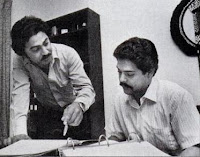Water-towers often offer a glimpse into the cities in which they reside in, so they are always a neat visual to look out for when traveling across the Rio Grande Valley. Usually these water-towers have the image of the local high school sports team logo, maybe a welcoming quote, or of some type of city accomplishment. One can make the argument that the South Texas water-tower that stands out the most is San Benito's 125 foot tower. The tower is emblazoned with the words "Hometown of Freddy Fender" and his iconic image.
Years before he was "Freddy Fender", Baldemar Huerta made his name in the Hispanic areas of Texas by recording Spanish covers of pop songs that spanned several different genres. Most of these songs were recored on Valley labels like Ideal Records out of San Benito and Falcon Records out of McAllen. Many years removed from that time period, he become a country star thanks to his 1976 hits "Wasted Days and "Wasted Nights" and "Before the Next Teardrop Falls". As great as he was in those years, his period as a member of The Texas Tornados super-group is my favorite period of his.
In 1992, the BBC series Rhythms of the World came down to San Antonio to record two episodes on "Tex-Mex" music. The first episode they filmed was an event that was headlined by Valerio Longoria and Esteban Jordan. It was a pretty spectacular concert, the high point being Jordan's version of "Georgia on my Mind". The second episode, which aired a week later on BBC, was headlined by The Texas Tornados.
There is nothing quite like a live performance of The Texas Tornados. One of the most surprising things is that they bust out their version of 96 Tears, the famous hit tune from Michigan garage band Question Mark & The Mysterians. It's great to see them performing some of their old hits, the best one being a Texas Tornados-version of the Sir Douglas Quintet classic "She's About a Mover". Enjoy the episode.
List of songs performed by "The Texas Tornados" on Rhythms of the World:
1.Who Were You Thinking Of?
2. Hey Baby (Que Paso?)
3. Laredo Rose
4. Soy De San Luis
5. Only One
6. Mendocino
7. Wasted Days and Wasted Nights
8. Is Anybody Going to San Antonio
9. She's About A Mover
10. 96 Tears


























